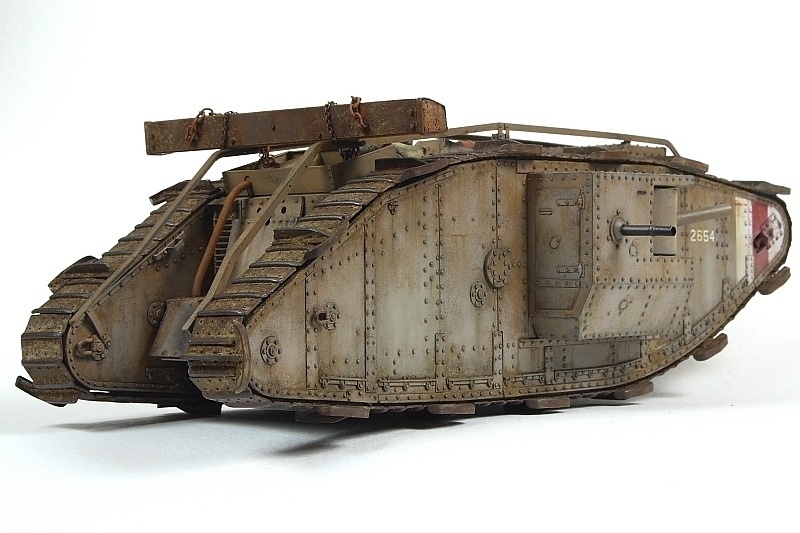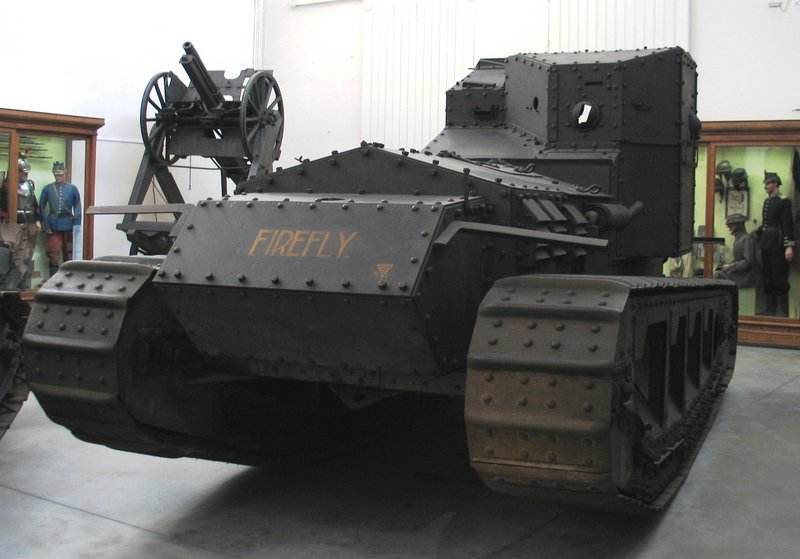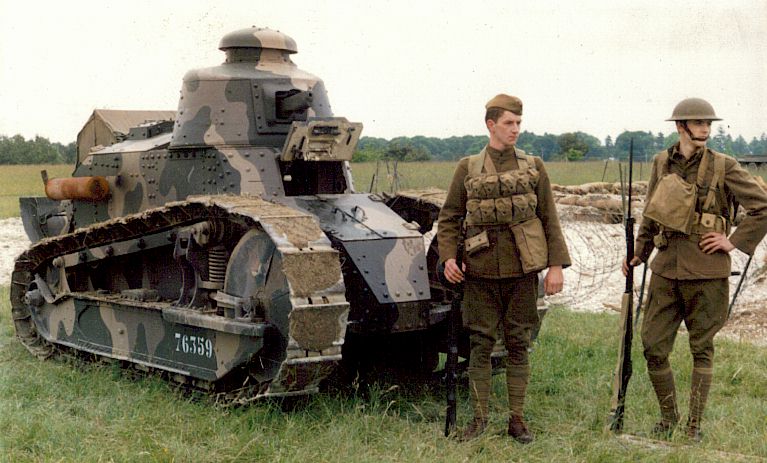It’s hard to think about warfare in the past century without conjuring up the image of the tank.
Today’s main battle tanks – nearly impregnable to any weapon that faces them on land – are like the land-battleships they were intended to be, 100 years ago.

British “Challenger II” main battle tanks. A Challenger scored the longest-ranged tank to tank kill in history – 5,000 yards. That’s three miles. With a first shot.
Some wars have involved vast fleets of tanks duking it out, in the desert…

Israeli “Patton” Tanks – US-built M-60s – maneuver across the Sinai in 1973.
…and the sub-arctic…

A British “Scorpion” “tank” (actually a light scout vehicle) in the Falklands in 1983. Although mostly intended for covertly snooping around enemy positions in Europe, it was heavier than anything the Argentinians had brought to the Falklands, and so may as well have been the above-mentioned Challenger II.
…and on the steppe.

German “King Tiger” tanks – the most powerful tank of World War II – at the Battle for Berlin.
Of course, at times the legend of impregnability was an illusion; beneath the hide of hardened steel, they were vehicles full of fuel and explosives and far-from-impregnable men.

An American “Sherman” tank, blown literally to pieces by an internal ammunition explosion. Those sides that are peeled open are 1.5-1.75 inches thick. The turret weighs something like five tons.
Today’s main battle tank is like a formula 1 car compared even to tanks from the 1970s; todays’ American M1 Abrams…

A pair of M1 Abrams tanks.
…is powered by turbine engine, has a laser range-finder integrated into a digital fire control system that allows it to score first-round kills while moving, against moving targets, at ranges well over a mile, firing hypervelocity rounds with tungsten or depleted-uranium cores that can slice through armor like it’s cardboard at ranges well over a mile.

Soviet-built T-72 tank, destroyed by an American tank round that drilled through the sand berm, and then through the armor.
And the concept got its first shakedown 100 years ago today.
The Battle of the Somme had been underway for a little over two months, after starting with the most horrendous bloodbath in Britain’s bloodbath-clogged history; it was only the latest, but among the worst, of a seemingly endless series of quagmires that dogged the Entente forces as they tried in vain to eke a breakthough of the German trench lines and find open country. The names – Ypres, Passchendaele, Verdun, Vimy Ridge – are different, but the results, muddy bloody quagmires that traded thousands of lives for bare yards of land, were all the same.
As the war ground down into a battle of attrition along a line of trenches in late 1914, a group of British captains and majors looked at the caterpillar tractors that some of the armies had started to use to haul artillery around in the mud – supplanting the teams of horses that still plied that miserable trade for most of the war – and started putting two and two together.

A casual group of French soldiers in 1915, with their American-built Holt tractor, hauling a cannon through the Vosges mountains.
Here as a vehicle that could move at some speed, anyway, through mud and over obstacles. Why not put the idea to use, the officers reasoned.
In a move that reads like a caricature of British military leadership, the Army’s officers dismissed the idea.
So the initial development of the idea was carried out by the Royal Navy – who had had some experience using armored cars on the Western Front, guarding flanks and covering movements:

A Royal Navy Rolls Royce armored car in Flanders, 1914
The idea famously caught the attention of Winston Churchill, at the time the First Lord of the Admiralty between various stints of dabbling at other roles. He reasoned that if battleships could rule the sea, they could rule the land as well – and so he convened the “Landships Committee”, a group headed by the Chief of Naval Construction and including a dizzying array of engineers and designers.
The Committee worked with William Foster and Company – an agricultural equipment maker – to produce the world’s first tank, “Little Willie”, in 1915.

“Little Willie” today. A prototype in every sense, it never saw action – but it’s recognizably a tank.
Churchill named the contraption a “Tank”, to try to fool German intelligence into thinking they were water carriers.
The design evolved rapidly over the next several months – until September 15, 1916, at the Battle of Fleurs-Courcellete, a part of the Somme campaign, when the first British Mark I tanks crawled over the barbed wire and bore down on a trench full of astonished, then panic-stricken, German defenders.

A Mark 1 “Male” tank. It was so named because it had, um, cannon – 1890-vintage castoffs from the Royal Navy – mounted in sponsons on the side of the hull, as distinguished from the Mark I “Female” variant, which had only machine guns. No, those were official designations. I’m not making this up.
Astonishingly, Churchill’s ruse worked; the Germans were completely surprised; some troops panicked and ran as their bullets bounced off the Mark 1’s thin armor; others extemporized; artillery was dragged into place to knock out a few; rolling barrages of artillery firing indirectly claimed a few more.
But mechanical problems knocked out most of the tanks – and there weren’t many to begin with; 4-6 of them accompanied each division of roughly 12,000 riflemen into the fray. Most of these groups had 1-2 still in service by the end of the first day – most of the casualties were breakdowns or vehicles that got stuck in ditches and craters too deep and slimy even for caterpillar treads to negotiate.
They were hell to fight in; the vehicles were cramped, full of weapons, ammunition and gasolilne; the engines were in the center of the crew compartment, where exhaust fumes from balky exhaust systems would give the crews hallucinations and make them terribly sick even in normal operations. And while rifle and machine gun fire couldn’t punch through the armor, it could punch out the rivets and send them ricocheting around with almost as much force as a bullet; a hit from anything bigger could ignite the gasoline, creating an inferno that the crew had a hard time escaping over all the obstacles and through the small, limited hatches.
The tanks were too few and too unreliable, and their crews too untrained, to break the stalemate at the Somme; with surprise lost, the Germans developed countermeasures – the anti-tank rifle (still in service in the early days of World War) with enough power to punch through the thin (a fifth to a quarter inch of armor – enough to turn rifle shots and shell fragments and little more) and anti-tank grenades.
But graduallly, as the vehicles, the training and the doctrine improved, tanks did make a difference, making attacks less suicidal, and eventually, by late 1917, helping the Allies re-establish, if not a “war of movement”, at least to break the absolute dominance of defense. At Cambrai in November 1917, large number of tanks with trained and experienced crews operating on relatively dry, uncratered ground were able to force a limited breakthough at relatively low cost.
It was a new technology – newer even than aircraft, which was not even ten years old when the war started. From the humble start of Little Willie, the evolved slowly during the war; British medium tank design philosophy didn’t change much from the rhomboid shape of the Mark I by the end of the war.

A British Mark IV Tank. More reliable than the Mark I, with two cannon, three machine guns and a crew of 8, it could cross the battlefield at three miles per hour – occasionally being outrun by its accompanying infantry.
The cavalry – mostly dismounted since the carnage of 1914 – saw an opportunity, and pressed for the development of “cavalry” tanks – “faster”, able to sweep through breakthroughs of the trenches to attack the enemy rear area.

A “Whippet” Mark A, capable of a blazing 8 miles per hour, with a crew of three and four machine guns.
And after years of frustration, it actually worked; at Amiens in 1918, Whippets outmaneuvered and destroyed several German infantry battalions; one tank, with its crew of three, advanced so far, so fast it got lost behind German lines, roaming like a bull in a china shop, destroying an artillery battery, a German observation balloon, the camp of an infantry battalion and division’s resupply column. This sort of carnage on the relative cheap caught the attention of a number of young officers – the British Basil Liddel-Hart and the German Erwin Rommel, who developed the idea further between the wars.
The French built tanks; the “Schneider” was as crude as Little Willy, but built in some numbers.
_tank.jpg)
French “Schneider” tank.
But the Renault “FT17” light tank, built in vast numbers, with a two man crew and a machine gun or light cannon, established a pattern that still holds for tanks today; a 360° tuirret on top, the engine in the rear, the driver low and up front in the hull. The Americans built them in huge numbers; George Patton commanded a battalion, and used it to good effect, cutting his teeth with the weapon that’d be the vehicle of his fame a generation later.

An FT17 with a couple of WWI re-enactors.
The Germans, caught by surprise, managed to build only a few dozen tanks of their own;

A German A7V. 20 were ever built.
They also deployed captured British and French tanks – never more than 2-3 dozen at a time, and never very effectively.

The Russkies unveiled their latest main battle tank, the T-14 Armata. It supposedly, is far superior to anything in the west. It’s got a 152 mm main gun, advanced armor and the emphasis is on crew protection.
Independent observers have also noted that in sheer numbers, Russia’s military hardware dwarfs the U.S. Towed and self propelled artillery and rocket systems, are also superior to ours overall.
The military strategy of the U.S. has relied too much on air superiority. There are concerns that if we go to war with Russia, we would lose that within days, due to Soviet anti aircraft systems and more capable aircraft.
Boss,
I disagree. Russian armor was easily tripped up in Georgia. And compared to American success in both Iraq wars, the Russians armor looks feeble. Matching or surpassing American armor and canon with new vehicles won’t make up for the training and integrated systems inside US tanks. And thanks to the two Iraq wars we have veteran high and mid level officers with combat experience. And you really can’t discount the air power which is now two generations beyond Russians.
“Emphasis on crew protection”
I suspect it’s PR, and all relative; the T72 (and related T90) which has been the standard Russian/Soviet tank for 30-odd years, is a total widowmaker.
In the T72’s first engagement against the Israelis, nine were destroyed. All 27 crewmen were killed. While casualties in knocked out tanks are always high, rarely is the rate 100%. They tended to explode.
The record in Desert Storm and the 2003 drive to Baghdad, the casualty rates were similarly terrible. And looking at some of the photos from the fighting in Ukraine, seeing T64/72/90-series tanks blown literally apart – to pieces – any improvement would be a huge step.
I wanted to be a tanker when I was a young ‘un–sad to say, the Army has this stupid rule that soldiers gotta be able to breathe, so my history of asthma kept me out. And then 25 years later, one of my good friends tells me he was a “speed bump” for the Soviets near Fulda for a few years.
Or maybe not such a speed bump, if our host is correct. If you read the history of the T-72 on Wiki, it exists because the engine on its predecessor cracked the frame and shell. In other words, for years the USSR was tolerating a design flaw that would have been solved in a week if it had happened at Freightliner or Mack. It just boggles the mind.